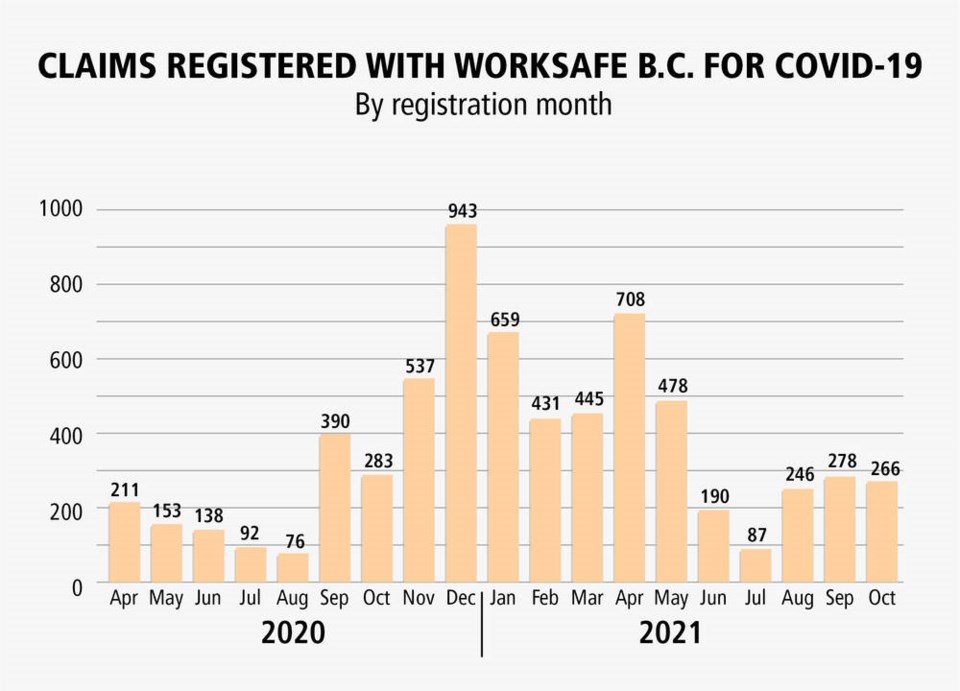The number of COVID-related claims filed with WorkSafeBC appears to be rising again, but may not reach last year’s levels due to high vaccination rates in the province, says the workplace safety organization.
Tanya Houghton, WorkSafe’s director of special care services, said illness claims received by the organization have consistently mirrored waves of the pandemic — as COVID cases started to rise again at the end of the summer, so did illness claims.
“As cases start to spike, it usually takes a few weeks to hit the [workplace] compensation system,” she said, adding: “The spike between July and August this year is substantially different than what we saw last winter, and with vaccination rates being what they are, that isn’t surprising.”
From a low of 87 COVID claims registered in July this year, it jumped to 246 in August, 278 in September and 266 in October.
At the same time last year, the low point was August, when 76 claims were filed, but that spiked to 390 in September before hitting the highest point of 943 claims filed in December.
Houghton wouldn’t say if she thinks the province could see another winter spike like last year, noting employers in general have been keen to work with prevention services and implement safety and social-distancing guidelines.
But she said with mask mandates and strong vaccination numbers, this year should be better than last.
The province’s most recent pandemic update showed 90.1 per cent of eligible people 12 and older in B.C. have received their first dose of COVID-19 vaccine and 85.5 per cent have received two doses.
Houghton noted that illness claims being filed with WorkSafe have shifted from predominantly health-care workers to other fields, as employers have started recalling workers, and offices and businesses have begun reopening.
Last summer, 75 per cent of claims were filed by health-care workers, while they now represent less than 50 per cent.
Houghton said claims in other sectors, including education, are expected to rise.
According to WorkSafe figures, of the 6,789 claims filed since the start of the pandemic, 3,119 have been in health care, 494 in education, 448 in business services, 343 in retail trade and 327 in agriculture.
When broken down into smaller classification units, long-term care saw the most illness claims filed with 1,141, followed by acute care at 1,140 and then the public school system at 466.
Teri Mooring, president of the B.C. Teachers’ Federation, said a high vaccination rate — about 95 per cent — among teachers has likely limited the number of claims filed so far.
She noted the bulk of teacher claims, about 75 per cent, come from elementary school teachers.
“That’s not surprising, given younger children were not vaccinated, and it’s also much harder to maintain physical distancing in elementary schools with younger children,” she said.
Mooring said it’s disappointing that the number is as high as it is, especially as the union has asked for more preventative measures in schools.
She said the fact that the province waited to see case counts before measures like mask mandates were implemented, rather than being proactive with steps such as testing in schools and ensuring each classroom has proper ventilation, is a sore point.
The union has also been critical of the amount and consistency of information provided on cases, possible exposures and outbreaks in schools, which Mooring argues can lead to larger-scale outbreaks.
She said when information isn’t conveyed to families and educators, they can’t make informed decisions — like postponing trips or birthday parties — that can limit the spread of COVID.
“For the most part, [safety measures] eventually get put in place, but it’s after a lot of advocacy and after people get sick,” she said.
“That’s been hard to understand.”



